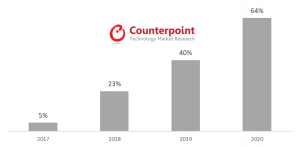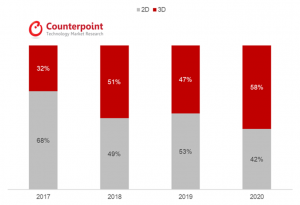
More than 1B smartphones to feature facial recognition
EP&T Magazine
Electronics Wireless Engineering Supply Chain Wearable Technology facial recognition facial recognition smartphones smartphonesFacial recognition solutions are expected to come to a wide range of handsets in 2018 following Apple’s FaceID and Samsung Galaxy Note 8’s Face & IRIS unlock technology. We expect more than one billion smartphones to feature some form of face unlock solution in 2020
When Apple announced Touch ID in 2013, it set a trend in consumer mobility. Smartphone OEMs around the world followed Apple’s example and integrated fingerprint sensors into their own devices. And they did so to such an extent that fingerprint-based security is now considered standard issue on even budget-priced smartphones. As a result, we estimate more than a billion smartphones will be shipped in 2018 sporting fingerprint sensors.
With the launch of Face ID, is Apple permanently ditching Touch ID for contactless authentication? Either way, inevitably, Apple’s rivals will adopt similar technology during 2018, which could lead to facial recognition becoming the de-facto standard for unlocking phones and the gradual elimination of fingerprint sensors in smartphones. Apple’s Face ID generates a 3D depth map of the user’s face that is achieved by the multiple sensors in its iPhone X. On the contrary, other players like Samsung rely on 2D facial recognition coupled with an iris scanner. OnePlus, on the other hand, relies on just 2D facial recognition. Going forward, we believe more OEMs will opt for facial recognition choosing between 2D and 3D facial recognition technology based on the price positioning of their product.
According to Counterpoint’s Component Tracker estimates, more than a billion smartphones will ship with facial recognition in 2020. Apple and Samsung will likely lead the pack for this new technology adoption, followed by Chinese players like, Oppo, vivo, Xiaomi, OnePlus, Huawei etc.
Exhibit 1: Smartphone Facial Recognition Feature Penetration of Smartphone Shipments Forecast

Source: Counterpoint Research – Component Tracker
Commenting on the research, Senior Analyst, Pavel Naiya, said, “The diffusion of facial recognition technology into lower tier price bands will be faster than any other flagship feature due to 2D facial recognition being native on the Android platform. However, according to our estimates, close to 60% of all smartphones with facial recognition, will use 3D technology in 2020. Data collected from multiple 3D sensors will assist emerging technologies like Augmented Reality, Virtual Reality and Artificial Intelligence to widen their use cases.”
Naiya added, “Sensor fusion will be more relevant than ever. It will likely open a new era of partnerships between OEMs (as data providers) and chipset manufacturers (as platform providers), to stay ahead of the race to democratize new technologies. We believe, new platform players will evolve in the smartphone component ecosystem by leveraging machine learning, data processing and sensor data to provide unique features in the latest smartphones.”
Security versus Convenience
A recurring theme when discussing biometrics is the balance between security and convenience, with the consensus being that convenience is generally more important than security to most consumers. But is facial recognition really a more convenient way to unlock a phone than fingerprint sensors?
“There are certainly situations where looking directly at a smartphone will be inconvenient, such as when walking briskly along a crowded street,” commented Peter Richardson, research director at Counterpoint Research. “In such cases, a fingerprint sensor may well be more convenient and quicker as it does not require the user to look directly at the device and could even be unlocked as it is being removed from the user’s pocket or bag. Although Face ID may not be the most convenient way to unlock a phone under all situations, it is well-suited for applications that require higher security, such as mobile payments, and where speed is not necessarily of essence. In such cases, consumers may be happy to wait longer, say 2-3 seconds, in return for a much higher level of security, such as when purchasing an expensive item using their phone.” added Richardson.
While there has been an undeniable trend towards contactless authentication during the past few months, predominantly to accommodate larger screens, Counterpoint Research believes that the fingerprint sensor is far from dead.
Hardware versus software-based authentication
Clearly Face ID will have a much wider application beyond authentication, including augmented reality and other applications which require accurate and sophisticated 3D sensing technology. However, cost issues will limit hardware-based 3D sensing to high-end phones, at least for the time being. This will create an opportunity for software-based facial recognition systems that can capitalise on the interest in facial recognition generated by Apple’s iPhone X and deploy these solutions in all but the premium flagship models.
Commenting on the technology potential, Counterpoint research director, Neil Shah said, “The use of AI-based machine learning algorithms coupled with ever faster processors, means that the latest software-only facial recognition technologies are able to overcome many of the traditional drawbacks of 2D face recognition and could become a real alternative to Face ID, at least for unlocking phones”.
He added further “Using technologies such as convolutional neural network-based algorithms and video-based ‘liveness detection’, companies such as FaceTec and Sensory claim that it is virtually impossible for a third-party to spoof their facial recognition with photos or video of the phone’s owner.”
Exhibit 2: Smartphone Facial Recognition Feature Penetration Forecast – by Technology

Source: Counterpoint Research – Component Tracker
Combination of biometric technologies
In future, Counterpoint Research expects mobile devices will combine biometric sensors for the face, iris, voice and fingerprints. Rather than competing against each other, each biometric technology will be layered on top of each other with the most convenient and least intrusive being selected on an application by application basis.
Neil Shah adds, “In 2018 we expect all leading handset manufacturers to launch flagship handsets with facial recognition capability. Some will also be inspired by Apple’s ‘notch’ design, though this won’t be necessary in every case to deliver the face recognition technology – it will be more of a fashion statement.” Shah adds further, “In addition to flagship products, we expect 2D face recognition will find its way into mid-range products from leading Chinese handset brands.”
—————————————————————————–
Note: Starting with Android 5.0 Lollipop, Google introduced a new Smart Lock system-which loosely categories as smartphone facial unlock. However, in this forecast, we only considered dedicated software/hardware functionalities provided by OEMs as facial recognition feature.
